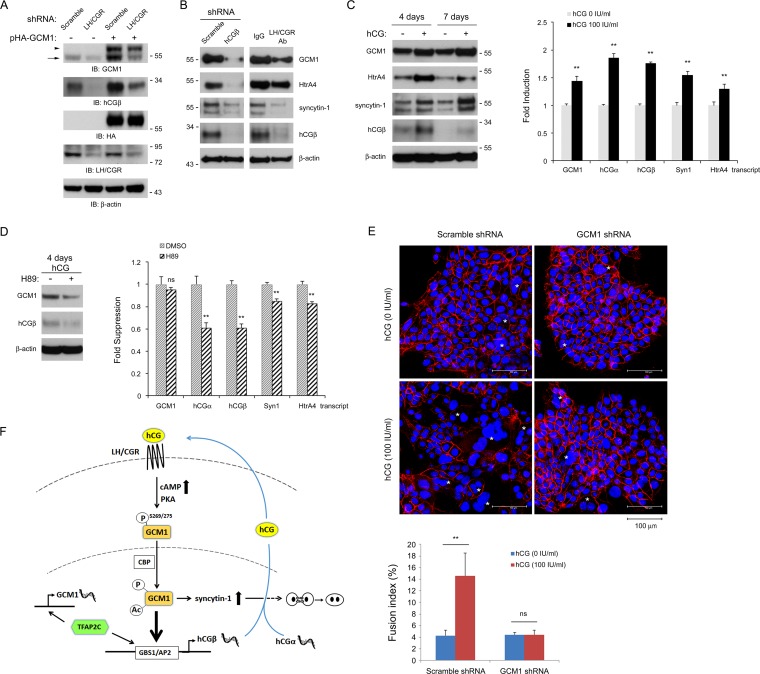FIG 8.
Regulation of GCM1 target gene expression and placental cell fusion by hCG. (A) Autoregulation of GCM1 is linked to the hCG-LH/CGR signaling pathway. JAR cells stably expressing scramble or LH/CGR shRNA were transfected with or without pHA-GCM1 for 48 h, followed by immunoblotting with the indicated Abs. Note that endogenous GCM1 (arrow) was not induced in LH/CGR knockdown JAR cells in the presence of HA-GCM1 (arrowhead). (B and C) hCG stimulates GCM1 and GCM1 target gene expression. (B) Scramble control or hCGβ knockdown BeWo cells were subjected to immunoblotting with the indicated Abs. On the other hand, BeWo cells were incubated with 4 μg/ml normal IgG or LH/CGR Ab for 72 h and then harvested for immunoblotting with the indicated Abs. Note that the endogenous GCM1 level decreases when hCGβ is knocked down or in the presence of LH/CGR Ab. (C) BeWo cells were mock treated or treated with 100 IU/ml hCG for 4 or 7 days. Cells were then harvested for immunoblotting with the indicated Abs. In separate experiments, BeWo cells treated with 100 IU/ml hCG for 4 days were subjected to qRT-PCR analyses of GCM1, hCGα, hCGβ, syncytin-1 (Syn1), and HtrA4 transcripts. (D) BeWo cells were treated with 100 IU/ml hCG plus 5 μM H89 for 4 days. Cells were then harvested for immunoblotting and qRT-PCR analyses as described above for panel C. Mean values and standard deviations obtained from three independent experiments are presented in panels C and D. **, P < 0.01 (compared with mock or dimethyl sulfoxide [DMSO] treatment). (E) Regulation of placental cell fusion by hCG. BeWo cells expressing scramble or GCM1 shRNA were treated with or without 100 IU/ml hCG for 4 days and then subjected to immunofluorescence staining with E-cadherin Ab. Fusion events and syncytium formation (denoted by asterisks) were examined by fluorescence microscopy. Quantification of the level of cell fusion is described in Materials and Methods. Mean values and standard deviations obtained from three independent experiments are presented. **, P < 0.01. (F) A positive feedback loop governs GCM1 activity, hCGβ expression, and placental cell differentiation. The binding of hCG to LH/CGR elevates the cAMP level to activate PKA, which phosphorylates GCM1 on Ser269 and Ser275. These phosphorylation events facilitate the interaction between GCM1 and CBP, which acetylates, stabilizes, and collaborates with GCM1 to activate hCGβ expression through GBS1. TFAP2C may mediate GCM1 expression and compete with GCM1 for GBS1 as well because it also harbors an AP2-binding site. Nevertheless, the activity of GCM1, but not that of TFAP2C, is stimulated by the cAMP-PKA signaling pathway to support the placenta-specific expression of hCGβ genes. Expression of the hCGα gene is also stimulated by hCG, and together with hCGβ expression, more hCG may be released to further activate the expression of GCM1 and its target genes such as syncytin-1 to promote placental cell fusion and differentiation.

